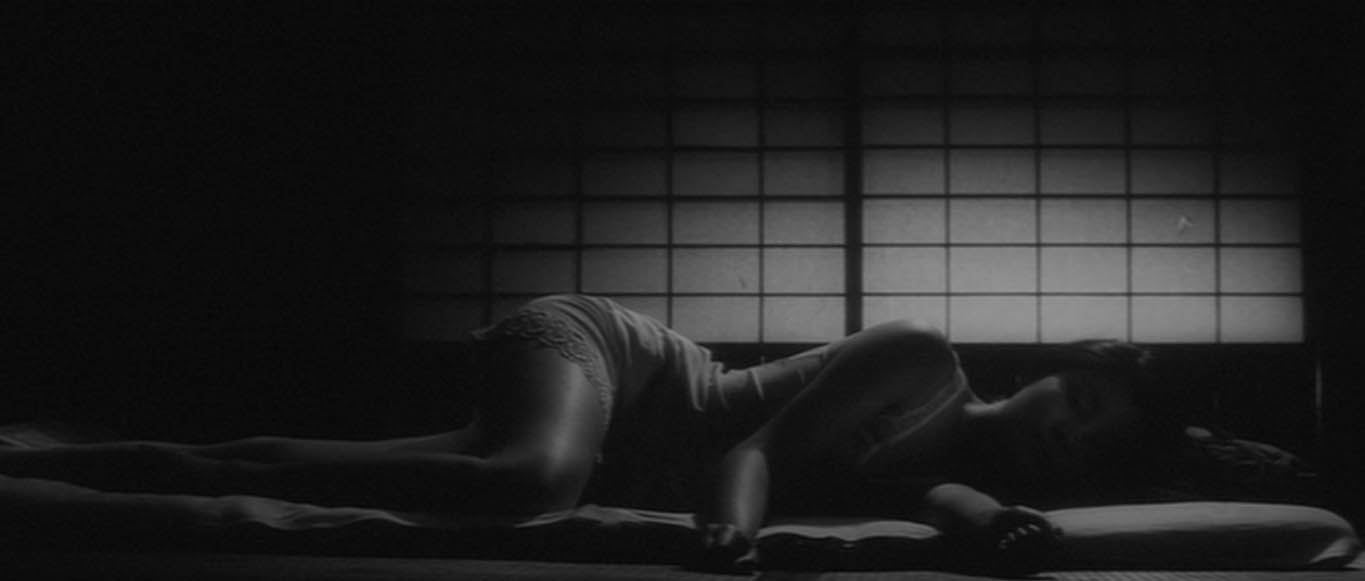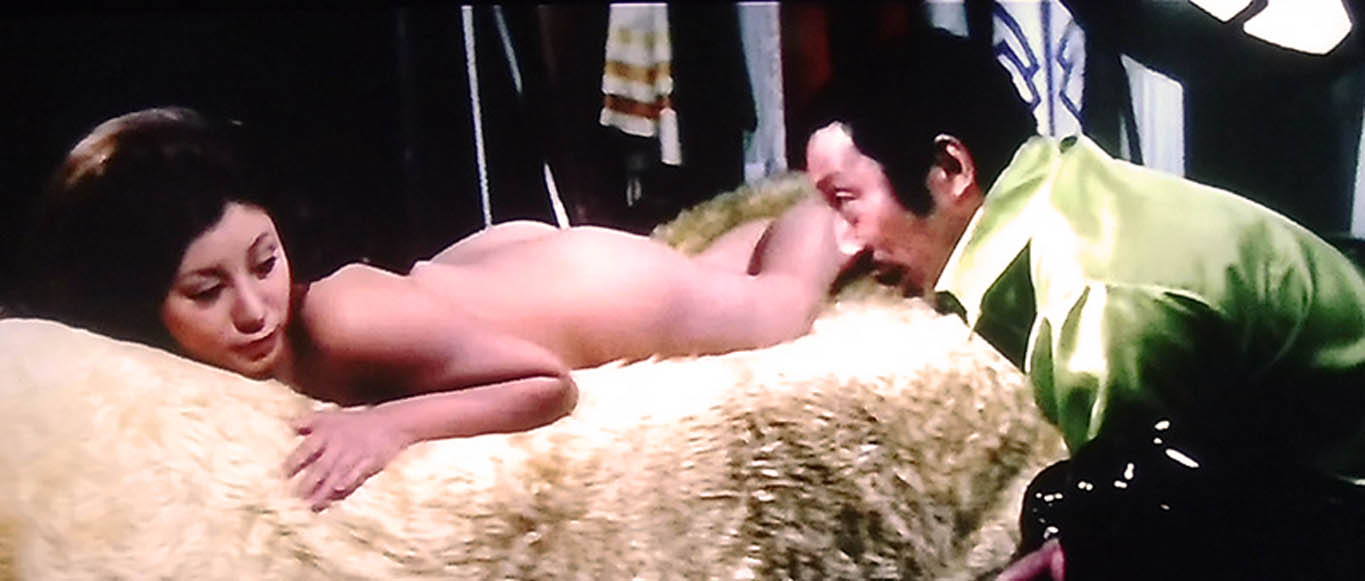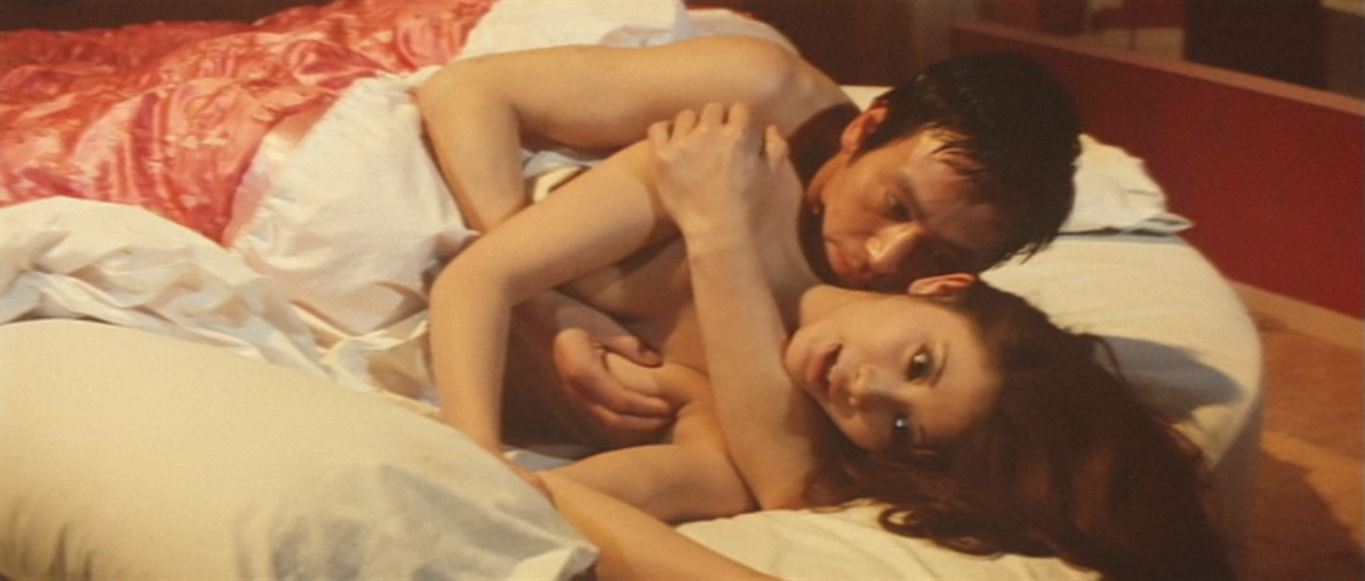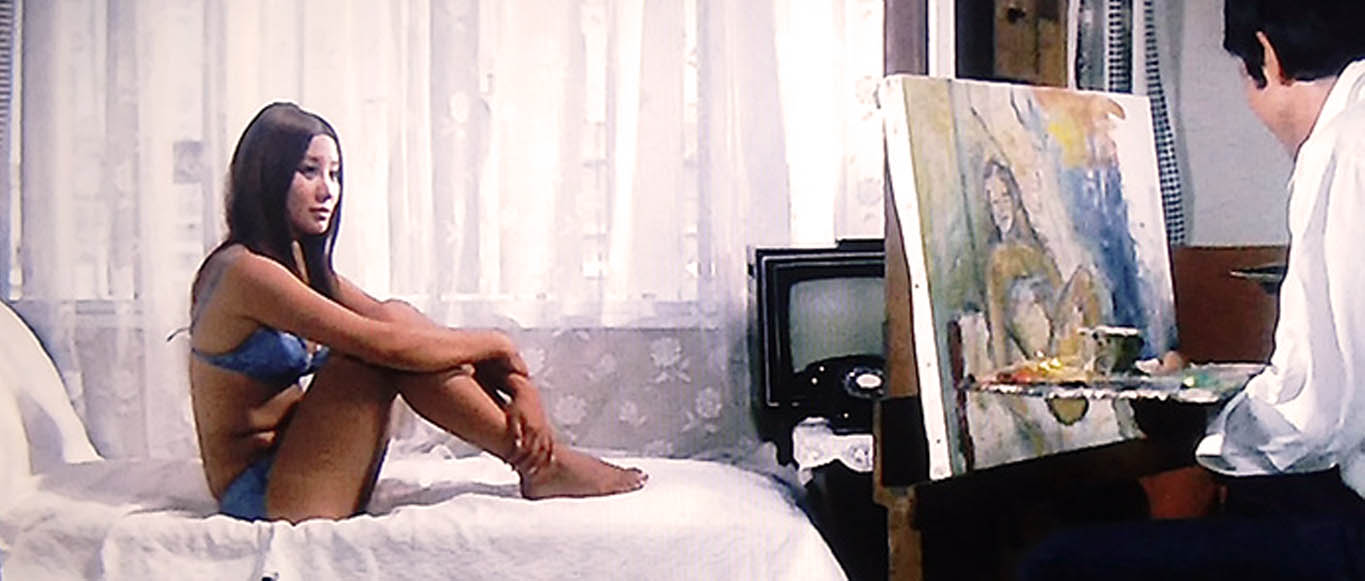
Regarded by many as Japan’s answer to Brigitte Bardot — both for her glamorousness and vaguely European looks (she wasn’t actually mixed-race) — Mari Atsumi became one of Japanese cinema’s most prominent sex symbols of the early 1970s.
As the daughter of Daiei actors Susumu Atsumi and Reiko Wakamiya, she too joined the studio in 1968 and soon found fame as the fifth and final member of the so-called “Shameless Group”. The Shameless Group consisted of Daiei’s top youth actresses at the time, who often formed a regular ensemble cast in a range of controversial dramas and sex comedies beginning with Record of a Girls’ High School Doctor: Pregnancy. As the Shameless Group films reached their pinnacle in 1969 with Dump, Hip, Bump: Give it to Me Guys!, Mari Atsumi was afterward given the chance to star as the lead in her first solo film.
Released in August 1969, Sea Anemone marked the turning point of Mari Atsumi’s career and would be the first of many solo films that rocketed the young actress to stardom in the following decade. Sea Anemone formed the first entry in what would become known as the “Mollusc Series” — a series of six films that provided some of Mari Atumi’s most popular and celebrated performances of her career.
The Mollusc Series earned its metaphorical name from the protagonists played by Mari Atsumi: all slippery, conniving and morally ambiguous women. The original titles of each film (Sea Anemone, Electric Jellyfish, Numbing Jellyfish, etc.) all further elaborate on this metaphor, bringing to mind beautiful yet deadly sea creatures. The general formula for these films surrounds a naïve Mari Atsumi being exposed to the vices of modern society and taken advantage of. As her skin thickens and her innocence is lost, she adapts to this new way of life and becomes cold and calculating. Most finales come out with her on top, usually at the expense of the men she has manipulated. As well as themes of lost innocence, the Mollusc Series across its six entries, also takes aim at the pop culture industry as a whole. Throughout the series, Mari Atsumi plays a variety of almost meta roles, portraying characters such as models and singers; pulling the curtain back on the dark underbelly of these seemingly glamorous professions that underpinned contemporary 70s culture.
Below we have reviewed the Mollusc Series as a whole. As some films are harder to find than others, we have marked the methods in which they can currently be viewed:
- Sea Anemone (1969) – Japanese DVD/Prime Video JP
- Sea Anemone 2 (1970) – Japanese VHS
- Electric Jellyfish AKA Play it Cool (1970) – Japanese DVD/Prime Video JP/fansubbed
- Nocturnal Sea Anemone AKA Innocent Sinner (1970) – Japanese VHS
- Electric Jellyfish: Cute Devil AKA The Good Little Bad Girl (1970) – Japanese VHS
- Numbing Jellyfish AKA The Hot Little Girl (1970) – Japanese DVD/Prime Video JP/fansubbed
Sea Anemone (1969)
(いそぎんちゃく) – Dir. Taro Yuge

Mari Atsumi plays Hanako – a beautiful young woman stuck in a dead-end job working and living at a laundrette. She dreams of more and looks on at a Ginza woman in jealousy as she walks in to collect her clothes. Strangely, the woman’s panties are missing – though rather than the owner being a pervert, it was Hanako who stole them for just a small taste of luxury. After an argument breaks out over the theft, she ends up sleeping with the owner and an affair develops. When his wife finds out, she eventually pays off Hanako’s wages for the month before ordering her to leave.
This is where Hanako’s true story begins as she goes through a string of lovers, from an elderly sugar daddy, his son, a handsome trumpet player, and a married businessman. She furthers her dream of becoming a Ginza girl with each encounter, whilst becoming ever more skilled as a manipulator. At first glance, it seems that men want to take advantage of Hanako, but she is always the one in control and always gets what she wants.
Sea Anemone is a deeply sexual film and easily the most psychological of the entire Mollusc Series. Despite the many uncensored views of Mari Atsumi’s body in all its glory, which would have still been considered fairly racy in 1969, this is certainly not a sexy film. Throughout the entire film, there’s a strangely dark and brooding vibe always sitting just below the surface. The main source of this vibe comes from the music. Instead of a fun late 60s soundtrack, we get something that more resembles a 50s noir mystery. At first, it seems a bizarre choice to use this music, especially during sex scenes, but it is extremely effective in building an unsettling atmosphere. Something just feels ever so slightly wrong, but it is hard to put your finger on it. We eventually find out later that this acts as foreshadowing for the character of Hanako herself.
At the start of the film, Hanako feels oddly unemotional – she sort of just stands there with a blank face and speaks almost robotically. As she gains more experience with lovers, she develops more emotions, learning how men want her to act. She starts to resemble a more normal woman, though it is all a mask. When the mask does eventually slip, she is colder and more calculating than ever. The mind of Hanako, who seems to be a psychopath, is brilliantly explored throughout the film, and Mari Atsumi gives what is essentially a double performance; one as the bubbly precocious young woman that all the dirty old men dream of being with; and one as an empty shell, devoid of human emotion and blank behind the eyes.
Interestingly, Sea Anenome is in black and white; even by Daiei’s low-budget standards, this was unusual for a late 1969 film. In fact, Mari Atsumi had already starred in several colour Shameless Group films earlier that year. It seems that Daiei was unsure about Mari Atsumi’s ability to carry a film on her own and only gave it a tiny budget. Director Taro Yuge doesn’t let the black-and-white limitations hold him back and celebrates the medium. He further builds on the noir vibes offered by the music and brings a murky, almost threatening aesthetic to the early film. Heat, both in a physical and in a lustful sense, is an ever-present feature of the film, and the black and white lighting allows the sweat on everyone’s skin to truly glisten as they seek refuge under the breeze of the many electric fans. Obviously, this also works to make the sex scenes feel extra sensual.
With the combination of the visuals and unsettling tone, coupled with Hanako’s duality, Sea Anemone feels almost Lynchian for lack of a better word. The tone throughout the rest of the Mollusc Series would become lighter with each entry, preferring to focus more on Mari Atsumi’s natural glamour. As a result, Sea Anemone stands out as a truly unique role for Mari Atsumi as she is really able to explore a wide range with the character of Hanako.
Sea Anemone 2 (1970)
(続・いそぎんちゃく) – Dir. Reijiro Usuzaka

We first meet Hamako (Mari Atsumi) as a schoolgirl. She has caught the eye of the creepy PTA president who has noticed how “mature” she is for her age. After getting her alone in his office, he attempts to force himself on her. Fortunately, the headmistress walks in before he is able to rape her, but since this is the early 70s, Hamako naturally gets blamed for seducing him. Thrown out of school in a shroud of disgrace, her foster parents are also unsympathetic; without a home to go back to, Hamako’s only choice is to take a train to the city in hopes of making something of herself.
On the train, she meets a kind woman whose husband runs a garage. Hamako is offered a job as a petrol pump attendant there, and soon the garage is inundated with customers who go there as an excuse to see the beautiful Hamako, although the flattery of this attention soon wears off as it is clear the men only want one thing from her. After a disastrous love affair with a young student ends in him being stabbed by a jealous rival, Hamako also has to deal with the garage owner becoming obsessed with her. When his wife catches him attempting to peep on Hamako in the shower, Hamako is told to find somewhere else to live and work.
Hamako then goes to the garage owner’s pervy friend who wants to use her to run his fortune-telling scam. Things end similarly, and she then ends up working as a singer in a club. Catching the eye of a talent scout, it seems that her fortunes might finally change. Despite not getting a record deal, she does meet a glamour photographer who wants her to become his muse. He is the first man that Hamako has ever met who has shown her any real kindness, and is also the only man who hasn’t tried to force himself on her. Naturally, she develops feelings for him, but is heartbroken when she finds out that he is actually gay.
The utterly dejected Hamako coincidentally runs into the ex-PTA president at the exhibition of her photos and falls back into his clutches. After more betrayal and a near-death experience, Hamako must once again pick herself up from the ashes to launch one final battle against a life where exploitation is around every corner.
Sea Anemone 2 was Mari Atsumi’s third solo film and marks her turning point from movie star to sex symbol. Whilst the film itself is nothing remarkable or explicit, the marketing campaign surrounding its release certainly made an impact. The nude glamour photos shown in the film were taken by leading photographer Yoshihiro Tachiki, and it is these that Daiei used heavily to promote the film (and most of the other films in the Mollusc Series). If you’ve ever seen a sexy photo of Mari Atsumi on the internet, chances are it was taken for this film. Similarly, Sea Anemone 2 also provided Mari Atsumi’s debut single “Cute Devil” – a release that would go down in Japanese music history as being the first record sleeve to show a fully naked woman.
Nevertheless, it is not a film without its high points. The first act of the film achieves an effectively oppressive atmosphere through unlikely means. Director Reijiro Usuzaka wraps Sea Anemone 2 in a surprisingly light veneer, making the film feel at times like a rom-com, complete with dreamy landscapes and fun incidental music. Despite this, he stays far away from making the film feel comedic, and the times when men assault or take advantage of Hamako are played completely seriously. The sudden juxtaposition of these acts against the fun exterior, makes them feel even more disturbing and reprehensible. This tone echoes the actions of the men in Hamako’s life, who beneath their kind smiles and joviality, hide a deep misogynistic desire.
With Hamako’s beauty, men instantly fall into lust with her (if they aren’t gay that is) and it is heart-breaking that instead of fighting against this attention, Hamako learns to surrender to it, presuming that this is the norm for her life as an attractive woman. The sex scenes carry a similar contrasting tone, with stereotypically romantic music accompanying Hamako’s barely concealed look of despair as she blankly gives in to her “lover.”
Unfortunately, as the first act comes to a close, Sea Anemone 2 has little else to bring to the table. Despite its 80-minute run time, a good 20 minutes are wasted on padding with the bizarre fortune-teller subplot overstaying its welcome with little impact on the overall story, other than giving Hamako another hurdle to clear. Sea Anemone 2 actually appears to get bored with itself by the final act and tacks on such a sudden finale that it cheapens many of the struggles Hamako has had to overcome.
Electric Jellyfish AKA Play it Cool (1970)
(でんきくらげ) – Dir. Yasuzo Masumura

Young Yumi (Mari Atsumi) has a chaotic home life – she lives alone with her mother who is an aging hostess. As such, it is common for her to stumble home drunk late at night, often with a temporary lover in tow. Despite this, Yumi is intelligent and hardworking and plans to enroll in seamstress college after her high school graduation. However, before she can move on to this next stage of life, her mother’s world once more hits her head-on.
Her mother has a new boyfriend who has been spending more time around the house. One afternoon, when Yumi is left alone with him, he rapes her. When her mother finds out what happened, her mothering instincts finally kick in, and she stabs him to death. With Hanako’s mother now in prison, her dreams of becoming a dressmaker are put on hold as she needs to find a job to pay off her mother’s debts.
Fortunately, the madam at her mother’s old club takes pity on her and gives her odd jobs to help out with. However, during a prison visit, her mother suspects that the madam wants to groom Yumi and warns her that under no circumstances is she to repeat her mistakes and become a hostess. Ultimately, the seductive glamour of the hostess trade – as well as the money it can command – becomes too much for Yumi to resist. With her youthful beauty and charisma, it is not long before she starts to outgrow the small nightclub, eventually graduating to Ginza – Tokyo’s high-class entertainment district.
Once there, she begins to make a name for herself by offering a very controversial specialty. As a skilled card player, she invites her clients to play her at poker – if they win, she will sleep with them free of charge. Now immersed in the world of prostitution, Hanako begins to lose grasp of the bright-eyed young woman she used to be. Soon friends and lovers are driven away, and even her mother barely recognises her as she slips further into the world of vice. Yumi’s path eventually leads her to a crossroads: does she come to terms with who she has become and attempt to redeem her former life; or does she carry on regardless, ploughing herself further into oblivion?
Not only is Electric Jellyfish one of the best films of the mollusc series, it is also one of the best hostess dramas from this era. Never afraid to shy away from the underlying exploitation of the hostess profession, Electric Jellyfish is an unrelentingly bleak tale that perfectly realises the key themes of the Mollusc Series, living up to its title’s deadly sting. The unflinching look at exploitation and prostitution of young women set both Electric Jellyfish and the Mollusc Series as a whole, apart from other films which use these themes as nothing more than an excuse to show flesh. Mari Atsumi absolutely owns her role and manages to portray the slow transformation from bright-eyed schoolgirl to conniving hostess so subtly that the audience barely notices it happening until it’s too late.
Whilst she may lose her innocence, Yumi never loses her underlying strength, and even when men seek to take advantage of her, she always calls the shots. Director Yasuzo Masumura always lets his female character’s inner strength shine through; despite her youth, Yumi maintains her agency and is far from being defenseless in the murky nightclub underworld. This lack of vulnerability is key in developing her character’s negative traits as she adapts to her new sleazy world. Throughout the film, it is made clear that Yumi remains responsible for her own actions and decisions – even the terrible ones. A standout turning point has her rejecting a chance of happiness with her lover in favour of becoming a live-in concubine for a rich elderly man.
Despite her questionable choices, the film also resists any degree of moralising and there is never any attempt to overtly denounce, or conversely justify, her actions. Even during Yumi’s foray into prostitution, she is not denigrated as a slut, she is merely a survivor who has to use any tool at her disposal. The prostitution subplot unexpectedly also introduces some interesting questions on morality. By this time, prostitution had been made illegal in Japan, so there is some understandable worry from the club owners that the police might shut them down for Yumi’s solicitation. On the other hand, this illegal enterprise is actually far less exploitative than the very legal hostess trade. As a prostitute who gambles with her body, Yumi is finally able to play by her own rules, taking power away from men. . Similar films from the previous decade such as Carmen from Kawachi or The Two Bitches transform their stories into tragedies, seemingly intent on punishing their protagonists for their immoral actions. Electric Jellyish instead stays neutral, giving Yumi a bittersweet ending of survival – but not necessarily happiness.
Nocturnal Sea Anemone AKA Innocent Sinner (1970)
(夜のいそぎんちゃく) – Dir. Taro Yuge

We start in a juvenile detention centre where Mari Atsumi plays a thief called Yoko. Yoko is far from being your typical delinquent – she is sweet, innocent, and kind. So kind in fact, that it’s revealed that she actually took the rap for her younger sister who is a kleptomaniac. Once released, she is taken under the wing of her probation officer who is a vicar. She joins his congregation and starts helping out around the church whilst also catching the attention of a few young men. This ultimately culminates in a love triangle between Yoko and a couple of lads. Yoko’s so naïve and innocent that she doesn’t see why she should choose just one boyfriend! Things get even more complicated one night, when the vicar walks in on Yoko and one of the boys doing naughty things behind the pews. Beneath the vicar’s outrage at their sacrilegious actions, there is also a palpable degree of jealousy.
He feels it best that Yoko distance herself from the church and he rents an apartment for her in the city. She starts working as a singer at a club and starts getting a name for herself. The vicar spends more and more of his time with Yoko and finds himself falling in love with her. However, when he abandons the church, and his wife, to become Yoko’s manager, things start to get complicated when it seems that Yoko might not necessarily share the same feelings that the vicar assumed she would.
In many ways, Nocturnal Sea Anemone feels like it should really be a comedy. The church setting is so over-the-top that it borders on the ridiculous, especially with a vicar adding a fourth edge to the love triangle. Then there’s also Mari Atsumi’s character which is almost comically innocent. Yoko despite her outward appearance, in many ways, has the brain of a child; she doesn’t really understand sex or love or even modesty. This eventually leads to the male characters projecting their own feelings onto her blank canvas, but also leads to scenes of her hanging out of her bedroom window in her underwear singing loudly while crowds of people gather below gawping at her. In many cases, it feels less of a criticism of men’s sexual hunger, and more as a fetishisation of innocence – where Yoko will pretty much sleep with any man that asks her because she doesn’t understand any better.
Speaking of sex, there may be a couple of love scenes in this film. “May” being the prominent term because, in keeping with the “Nocturnal” part of the title, Taro Yuge made the strange decision to film all of the night scenes completely unlit. These scenes purely consist of total blackness with some voices bouncing around. I’ll give him the benefit of the doubt by assuming he was making a commentary on the all too common exploitation of Mari Atsumi’s body in marketing the films of the Mollusc Series (the nude photo used on the poster actually comes from the Sea Anemone 2 set.)
In the end, Nocturnal Sea Anemone lacks any real sin and devolves into a slow and overly wordy rom-com which is missing the comedy. The end of the film shows Yoko and her sister hanging out in a theme park, further highlighting the fact that nothing really happened. Life just continues unchanged.
Electric Jellyfish: Cute Devil AKA The Good Little Bad Girl (1970)
(でんきくらげ 可愛い悪魔) – Dir. Reijiro Usuzaka

Electric Jellyfish: Cute Devil surrounds fashion-obsessed country girl Yumi (Mari Atsumi) who travels to Tokyo to stay with her older sister and soak in the culture of the big city. Once there, she meets her sister’s sort-of boyfriend and the two of them quickly hit it off, managing to spend a lot of time together whilst her sister is busy working during the day. Feelings quickly ignite between them, all culminating in a romantic trip to the beach. Once Yumi’s sister finds out about their burgeoning love affair, she dumps a bucket of water over her head and kicks her out.
Stuck in Tokyo with no place to go, Yumi has no choice but to hang around bars, where she meets a photographer who persuades the penniless young woman to do a shoot. However, much to Yumi’s shock, it is a nude lesbian S&M shoot in a graveyard; after she gets chained up and whipped, she understandably scarpers. Following this, Yumi then starts hanging out with a troupe of hippy performance artists; culminating in a dope-fuelled orgy which she also runs from.
Finally, things start to look up for her when she gets introduced to a singer and is even invited onstage, impressing everyone with her voice. However, instead of the promise of a potential career, the singer tries to rape her. After finding a stable job as a painter’s muse, Yumi finally gets a break and makes strides into the world of fashion modeling. However, Yumi’s past comes back to haunt her when the sleazy S&M photographer attempts to blackmail her with some very compromising photos, threatening to destroy the reputation of Japan’s latest top model.
Despite carrying the “Electric Jellyfish” moniker, Electric Jellyfish: Cute Devil feels like more of a remake of Reijiro Usuzaka’s earlier Sea Anemone 2. The story largely follows the same beats with Mari Atsumi’s protagonist passing from pillar to post before coming out on the other side as a model (this time a fashion model instead of a glamour model). Whilst the weakness of Sea Anemone 2 came from its uneven and inconsistent plotting, Electric Jellyfish: Cute Devil overcomes this – albeit in an unlikely way.
Electric Jellyfish: Cute Devil effectively drops any semblance of a plot so to speak. Best compared to a story like Alice in Wonderland, the film follows Yumi down the rabbit hole as she encounters an ongoing series of quirky and colourful characters. Due to this dynamic, the enjoyment of this film heavily relies on the audience’s fondness for Mari Atsumi. The fan service (not necessarily sexual) is plain to see, and whilst Mari Atsumi fans — both male and female — will be perfectly happy tagging along with their favourite actress as she explores the full breadth of 1970s pop culture, others hoping for a more dramatic experience will probably be disappointed.
Numbing Jellyfish AKA The Hot Little Girl (1970)
(しびれくらげ) – Dir. Yasuzo Masumura

Mari Atsumi stars as Midori — a fashion model whose life is seemingly going perfectly. Not only is she the top model at her agency, she’s also engaged to be married to the advertising executive at a prominent clothing firm. However, trouble soon brews when her fiancés firm is on the verge of signing a landmark international deal with an American company; the American CEO is playing hardball and refuses to sign the contract unless he gets the chance to sleep with Midori. After Midori reluctantly agrees to go along with the indecent proposal to help her fiancé’s career, their relationship is understandably on the rocks following her night with the lecherous American CEO. She decides to move back in with her father for a short time to give herself some space, but that’s easier said than done.
Her father is a penniless gambler and drunk, who isn’t beyond rifling through his daughter’s purse for some extra cash. One day, when he’s at a bar boasting about his famous model daughter with a magazine in hand, he attracts the attention of some very unsavoury customers. Seeing the potential Midori could bring them, a group of yakuza pimps end up blackmailing Midori’s father and giving him an ultimatum: either he pays them an impossible sum of money, or they take his daughter to pimp out. When Midori finds out the trouble that the men in her life have brought her, she has to take matters into her own hands and decide the kind of life that she really wants to live.
Numbing Jellyfish’s protagonist Midori is probably Mari Atsumi’s most meta role of the series, which sets the early film in good stead. Mari Atsumi had quickly become one of the most enduring sex symbols of the early 70s, and in between shooting films, was constantly appearing in the pages of every pop culture magazine of the era. The world of modeling depicted in Numbing Jellyfish is definitely one that Mari Atsumi inhabited in real life (hopefully with far less sleaze for her sake), giving an extra degree of believability for the audience.
Starting strongly with its wickedly sordid “Indecent Proposal“ trope, which perfectly fits in with the larger themes of the Mollusc Series, Numbing Jellyfish has all the ingredients to be a potential high point of the series. Unfortunately, with the introduction of Midori’s father, all the initial momentum of the film is lost. Ryoichi Tamagawa seemingly plays the role of her father for laughs which brings a difficult juxtaposition to the seriousness of the rest of the story. Further highlighting this point is Mari Atsumi’s lack of screen time. For the first time in the entire Mollusc Series, its star feels side-lined in favour of the rest of the cast, compromising Midori’s own struggles rather than the stories of the male characters. Whilst attention eventually shifts back to her for the finale, her absence throughout the middle act makes the ending feel unearned as a large portion of her character development happens offscreen.
After six films, the Mollusc Series was showing clear signs of fatigue. With the exception of Sea Anemone, there was little variation in the films’ protagonists, and coupled with the fairly rigid story formulas of the various entries, it was probably inevitable that Numbing Jellyfish would mark the end of the series. Whilst Numbing Jellyfish doesn’t finish the series off with a bang, it is still a solid entry, which despite its missteps, delivers a succinct indictment of the exploitative fashion industry, and the greed of men who are all too willing to overlook the women in their life as pawns to be used and possessed.

Hi, I have a borderline obsession with Japanese showa-era culture with much of my free time spent either consuming or researching said culture. Apparently I’m now writing about it as well to share all the useless knowledge I have acquired after countless hours surfing the web and peeling through books and magazines.
